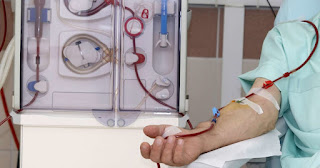what is dialysis
A healthy and balanced person's kidneys filter about 120 to 150 quarts of blood every day. If the kidneys are not functioning properly, waste develops in the blood. Eventually, this can lead to coma and fatality.
The cause may be a persistent, or long-lasting problem, or an severe problem, such as an injury or a temporary disease that affects the kidneys.
Dialysis prevents the waste items in the blood from getting to dangerous degrees. It can also remove toxic substances or medications from the blood in an emergency situation setting.
Kinds of dialysis
There are various kinds of dialysis.
The 3 main approaches are:
Periodic hemodialysis (IHD)
Peritoneal dialysis (PD)
Continuous renal substitute treatments (CRRT)
The choice will depend upon factors such as the patient's circumstance, accessibility, and cost.
Periodic hemodialysis
In hemodialysis, the blood distributes outside the body. It undergoes a device with unique filterings system.
The blood appears of the client through a versatile tube known as a catheter. Television is inserted right into the capillary.
Such as the kidneys, the filterings system remove the waste items from the blood. The filteringed system blood after that returns to the client through another catheter. The system works such as a synthetic kidney.
Those that are mosting likely to have hemodialysis need surgical treatment to expand a blood vessel, usually in the equip. Enlarging the capillary makes it feasible to place the catheters. cara ampuh menang judi sabung ayam
Hemodialysis is usually done 3 times a week, for 3 to 4 hrs a day, depending upon how well the kidneys work, and how a lot liquid weight they have gained in between therapies.
Hemodialysis can be performed in an unique dialysis facility in a medical facility or in your home.
Individuals that have dialysis in your home, or their caregiver, must know exactly what to do.
If an individual doesn't feel great doing dialysis in your home, they should attend sessions at the medical facility.
Home hemodialysis appropriates for individuals that:
have remained in a steady problem while on dialysis
don't have various other illness that would certainly make home hemodialysis hazardous
have appropriate capillary for inserting the catheters
have a caregiver that wants to assist with hemodialysis
The home environment must also appropriate for taking hemodialysis equipment.
Peritoneal dialysis
While hemodialysis eliminates pollutants by filtering system the blood, peritoneal dialysis works through diffusion.
In peritoneal dialysis, a sterilized dialysate service, abundant in minerals and sugar, is go through a tube right into the peritoneal cavity, the stomach body cavity that borders the intestinal tract. It has a semi-permeable membrane layer, the peritoneal membrane layer.
Peritoneal dialysis uses the all-natural filtering system ability of the peritoneum, the interior cellular lining of the abdominal area, to filter waste items from the blood.
The dialysate is left in the peritoneal cavity for some time, so that it can take in waste items. After that it's drained pipes out through a tube and disposed of.
This trade, or cycle, is normally duplicated several times throughout the day, and it can be done over night with an automatic system.
The removal of undesirable sprinkle, or ultrafiltration, occurs through osmosis. The dialysis service has a high focus of sugar, and this causes osmotic stress. The stress causes the liquid to move from the blood right into the dialysate. Consequently, more liquid is drained pipes compared to is presented.



